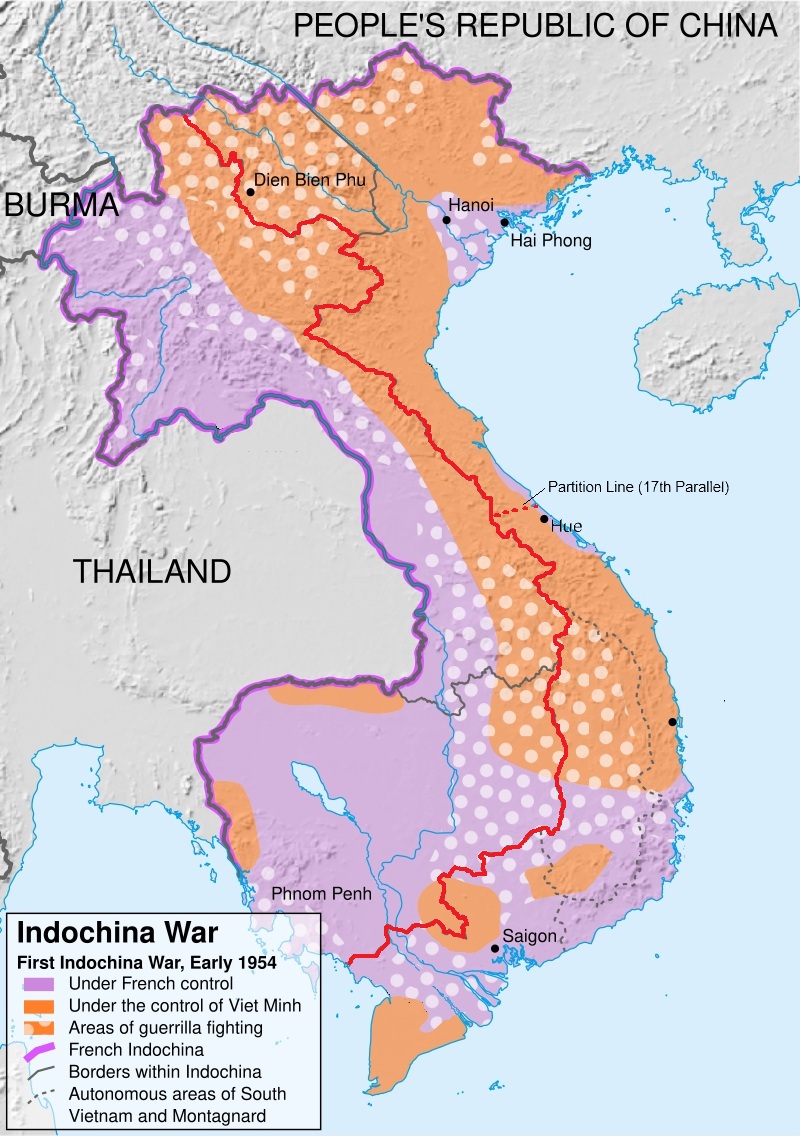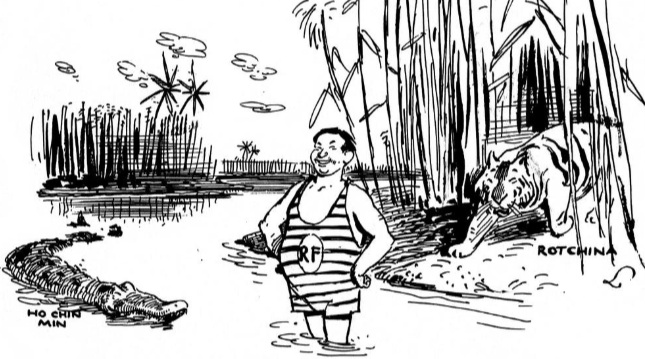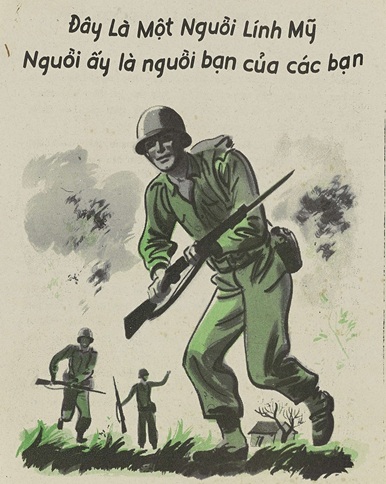|
|
NOTE: this topic is a stated topic on the AQA and iGCSE specifications. It is NOT a topic on the Edexcel specification. It is, however, important background knowledge about how the Vietnam War developed.
|
BackgroundWhen the Second World War broke out, Vietnam, Laos and Cambodia were part of French Indo-China, ruled by France since the 19th century – although the Vietnamese Emperor Bao Dai remained as a nominal figurehead. Indo-China’s huge rice production, along with coal and rubber, made it a valuable colony. During WWII, Japan occupied Indo-China, keeping the French administration in place but stripping resources worth $2 billion for their war effort (including 90% of motorised vehicles, plus innumerable boats and railways). This led to the devastating famine of 1945, in which up to 2 million Vietnamese died. Vietnamese resistance grew during the war. In 1941, Ho Chi Minh and Vo Nguyen Giap founded the Viet Minh, fighting both French and Japanese. From their base in southern China, they launched guerrilla attacks, with support and weapons from China and the US. By 1945, the Viet Minh had a 5,000-strong army, and in April held the Tonkin Revolutionary Military Conference calling for a general uprising against the Japanese. Japan’s surrender in August 1945 left a power vacuum: the French had been driven out, the Japanese were gone, the Chinese were occupying the north of Indo-China, and the American Office of Strategic Services (OSS) Team had parachuted into the country as part of Operation Embankment, to recover American POWs and secure American interests in French Indochina.
|
Going DeeperThe following links will help you widen your knowledge: Basic accounts of the First Indochina War and Dien Bien Phu - from Clever Lili
YouTube Dien Bien Phu and The Geneva Accords - Mr Cloke Chiến Thắng Điện Biên - Viet Minh Dien Bien Phu victory song.
|
The First Indochina War, 1946-54 On 2 September 1945, Ho Chi Minh declared the Democratic Republic of Vietnam, quoting the American Declaration of Independence that “all men are created equal”. Bao Dai was persuaded to abdicate and become an ‘adviser’ to Ho’s new government. However, France had no intention of letting Indo-China go. General Leclerc arrived in October 1945 to reassert French rule, especially in the south. The Viet Minh faced opposition not only from the French but also from rival Vietnamese groups, such as the Hoa Hao and Cao Dai religious militias and criminal groups like the Bình Xuyên. Conflict exploded on 1 November 1946 when the French cruiser Suffren shelled Haiphong, killing perhaps 6,000 civilians, and beginning the First Indochina War. The French strategy relied on conventional warfare, using French troops and 300,000 (unreliable) Vietnamese soldiers. In 1947, by the Ha Long Bay Agreement, the French set up a Vietnamese puppet state under Bao Dai, which allowed the US to officially recognise Vietnam and start sending military aid. The Viet Minh, however, supported by China from 1950, fought a guerrilla war, using forests and villages to their advantage. Consequently, although they controlled the towns, and despite $3 billion US financial aid, the French struggled to control the countryside. By the end of 1952 the French had lost 90,000 dead. In summer 1953, therefore, taking advice from US military advisers that they were not being aggressive enough, the French launched an offensive – the 'Navarre Plan' – to try to regain the initiative. As part of this, they reoccupied the Dien Bien Phu valley in the far north of the country. It was a mistake. In March 1954, the Viet Minh, carrying supplies on bicycles and dragging heavy artillery through jungle terrain by hand, surrounded Dien Bien Phu with 60,000 soldiers and cut off the French from their supports. A brutal siege followed, during which the US Army’s G3 Plans Division recommended using atomic weapons to relieve the French garrison. This was not done, and Dien Bien Phu fell on 7 May 1954: only half the 13,000 French soldiers survived to surrender.
|
Source AGiap and the Viet Minh grasped the strategic significance of Dien Bien Phu while Navarre and his subordinates did not. In addition, the fact that the French put several of their most elite combat units in a situation where they had to fight for months against overwhelming odds shows that the French high command had disastrously misunderstood Viet Minh intentions and capabilities ... conducting a war while being bankrolled by another country led to a lack of discipline in French strategic thinking. Mike Hennelly, Strategic Lessons of Dien Bien Phu (2021).
Source BFor 56 days they had given everything, endured everything... They deserved to win; and if they were now being robbed of victory, then the real thieves weren't the [Vietnamese] People's Army, or anyone else in the filth of this last valley, but men who slept between clean sheets far away.” Martin Windrow, Dien Bien Phu & the French Defeat in Vietnam (2004).
Source COur troops have liberated Dien. Chiến Thắng Điện Biên (Dien Ben Victory).
|
Source D
This February 1950 cartoon by the German artist and cartoonist Ernst Maria Lang shows the 'Emperor' Bao Dai, wearing his 'Republic of France' swimsuit, declaring: "They won't dare – because I'm wearing a very diplomatic luxury bathing suit!". 'Rotchina' = 'Red China'.
|
Source E
This leaflet, dropped into Vietnam by American planes in 1945, declares: "This is an American soldier. He is your friend".
|
The Geneva Accords, 1954The defeat at Dien Bien Phu shattered French resolve. On 8 May 1954, peace talks (involving France, the Viet Minh, the USSR, China, the USA & Britain) began in Geneva. After long negotiations, the Geneva Accords were agreed on 21 July 1954: • Indo-China was divided into Laos, Cambodia, North Vietnam and South Vietnam; Vietnam was split along the 17th parallel. • Ho Chi Minh’s Communists ruled the North, Ngo Dinh Diem (a Vietnamese nobleman living in exile in a Catholic seminary in New Jersey) took control in South Vietnam with US support. • Free elections would be held in Vietnam by July 1956 to decide how the country would be re-unified. • No foreign power to intervene in Vietnam's affairs. Nobody signed the Final Agreement. America openly rejected it, and neither Diem nor Ho Chi Minh intended to keep it.
|
Consider:1. Using the information on this weboage, explain to a friend how the French came to be driven out of Indochina. 2. Now, working together, make a list of Reasons the French lost the First Indochina War, 1945-54.
|
Consider:3. Suggest reasons why: 4. Make a list of the fundamental issues underlying the Viet Minh resistance; did the Geneva Accords solve any of them? 5. Make a list of evidence which shows that the Americans were heavily involved in Vietnam from the very start.
|
|
|
|
|
|
Spotted an error on this page? Broken link? Anything missing? Let me know. |
|

